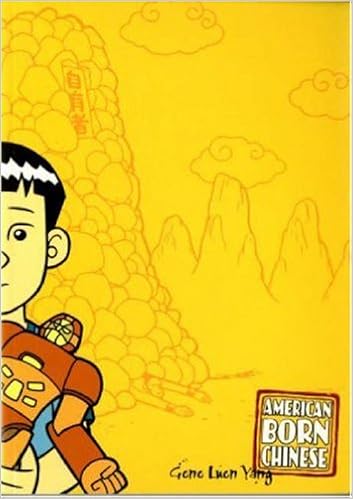
http://ecx.images-amazon.com/images/I/51x0DO6FYPL._SX351_BO1,204,203,200_.jpg
Bibliographic Information:
American Born Chinese by Gene Luen Yang
ISBN 978-0-312-38448-7
2006 Square Fish/Macmillan New York, NY
Plot Summary:
American Born Chinese
is a graphic novel that weaves together 3 stories to complete the circle of a
story that begins with the legend of the Monkey King. The Monkey King wants to
be included in festivities in the heavens, so he studies the art of Kung Fu and
the heavenly disciplines so that he can be worthy of inclusion in the Heavenly
parties. The second strand in the graphic novel is the story of Jin Wang, a
Chinese American boy who is in love with an All American Girl. Jin Wang becomes
friends with a new immigrant from Taiwan and their friendship becomes his
refuge. The third narrative is about All American Danny, who is terrorized by
an annual visit by his Chinese cousin Chin-Kee. He is so embarrassed by
Chin-Kee’s visits that he changes schools every year. As Monkey learns that he
cannot out reach the gods, Jin Wang learns that he will always be Chinese, and
Danny learns to accept his Chinese identity, too. All of these stories are
woven together in the end by the Monkey King.
Critical Evaluation:
American Born Chinese
uses color drawings with comic book narration and dialogue to tell three
apparently unconnected stories. Each section is divided to uphold that
separation, but the drawings are the same style throughout, implying
connection.
The use of the Chinese
Folk Tale about the Monkey King in connection to young Chinese American men has
some good elements of foreshadowing. The Monkey King’s weakness is wanting to
be something other than himself and the boys’ problems happen when they try to
change who they are.
The characters who use
some of the negative stereotypes of Chinese Americans can be a little jarring
for a politically correct audience. The fact that Chin Kee is named what he is
and that he pronounces English words in such stereotypically bad ways could
perpetuate a racist idea about Chinese immigrants. I guess this problem goes
away when the author himself is Chinese American.
This graphic novel won
so many awards that it can only open doors for cultural exchange through comic
format. The style of this comic does not imitate Japanese Manga, which is not
related to the Chinese folklore this explores. I think the style reflects
something more like Archie Comics, which is accessible to American kids.
Reader’s Annotation:
The Monkey King wants to be better than monkeys, Jin
Wang wants to hide his Asian identity and Danny holds on to his All American
identity. When the strands come together, we learn to be proud of our
identities.
Author Information:
Hi! I’m Gene Luen Yang. Thanks for visiting my site! I began making comics and graphic novels over fifteen years ago.In 2006, my book American Born Chinese was published by First Second Books. It became the first graphic novel to be nominated for a National Book Award and the first to win the American Library Association’s Printz Award. It also won an Eisner Award for Best Graphic Album – New.In 2013, First Second Books released Boxers & Saints, my two-volume graphic novel about the Boxer Rebellion. Boxers & Saints was nominated for a National Book Award and won the L.A. Times Book Prize.I’ve done a number of other comics, including Dark Horse Comics’ continuation of the popular Nickelodeon cartoon Avatar: The Last Airbender and DC Comics’ Superman!
In addition cartooning, I also teach creative writing through Hamline University’s MFA in Writing for Children and Young Adults.
retrieved from: http://geneyang.com/about on 8/3/2015
Genre(s):
Graphic Novel, Fiction
Curriculum Ties:
Multiculturalism, Chinese American Culture
Booktalk Ideas:
This title lends itself
to talks about Chinese folklore, cultural sensitivity, and graphic novels as
literature.
Reading level: Grade 5+
Interest age: 11+
Challenge Issues: There are no apparent challenge issues. Any questions about the title refer to the Challenge Defense File
Why I chose this book:
This book is a Printz Award Winner and a great example of how graphic novels represent literature.
No comments:
Post a Comment